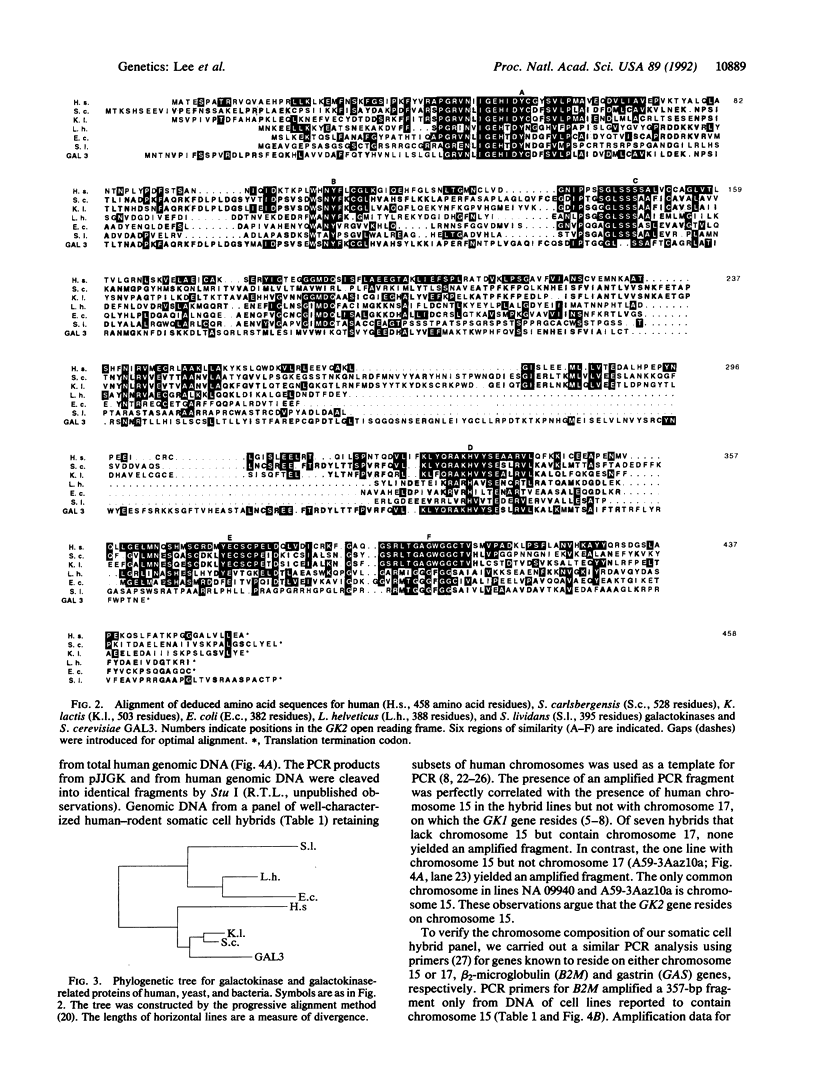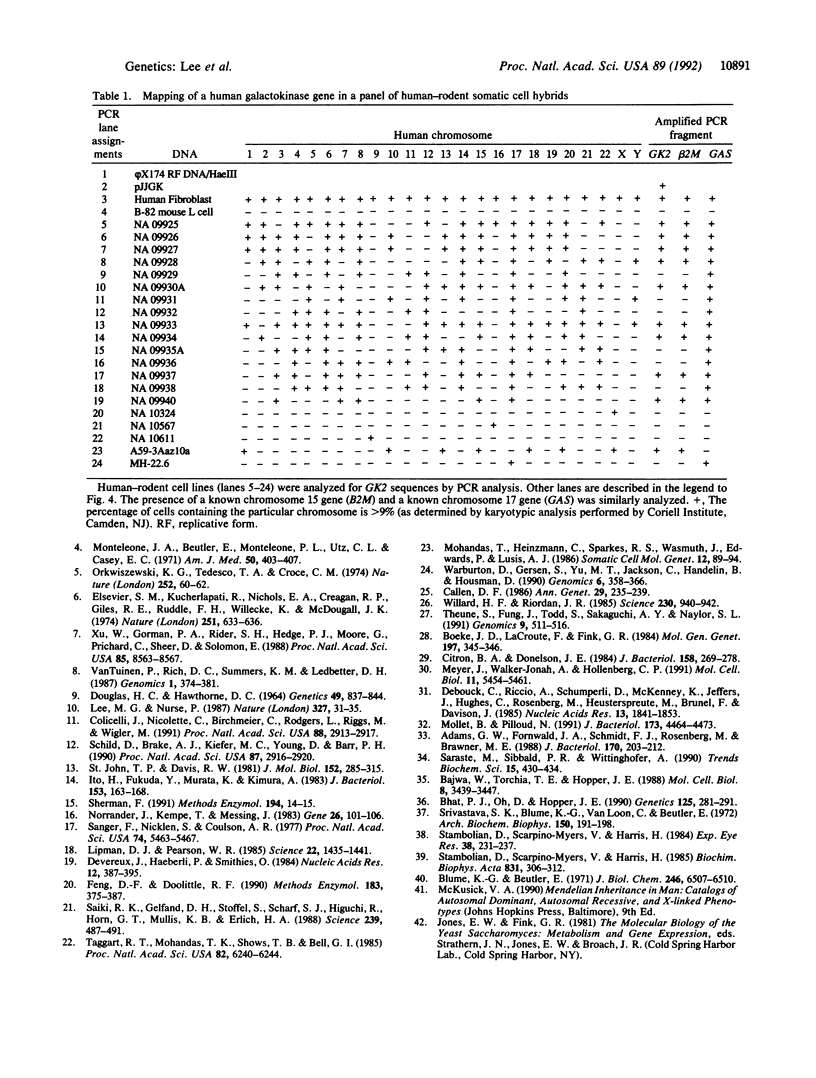Abstract
A human cDNA encoding a galactokinase (EC 2.7.1.6) was isolated by complementation of a galactokinase-deficient (gal1-) strain of Saccharomyces cerevisiae. This cDNA encodes a predicted protein of 458 amino acids with 29% identity to galactokinase of Saccharomyces carlsbergensis. Previous studies have mapped a human galactokinase gene (GK1) to chromosome 17q23-25, closely linked to thymidine kinase. The galactokinase gene that we have isolated (GK2) is located on chromosome 15. The relationship between the disease locus for galactokinase deficiency galactosemia, which is responsible for cataracts in newborns and possibly presenile cataracts in adults, and the two galactokinase loci is unknown.
Full text
PDF




Images in this article
Selected References
These references are in PubMed. This may not be the complete list of references from this article.
- Adams C. W., Fornwald J. A., Schmidt F. J., Rosenberg M., Brawner M. E. Gene organization and structure of the Streptomyces lividans gal operon. J Bacteriol. 1988 Jan;170(1):203–212. doi: 10.1128/jb.170.1.203-212.1988. [DOI] [PMC free article] [PubMed] [Google Scholar]
- Bajwa W., Torchia T. E., Hopper J. E. Yeast regulatory gene GAL3: carbon regulation; UASGal elements in common with GAL1, GAL2, GAL7, GAL10, GAL80, and MEL1; encoded protein strikingly similar to yeast and Escherichia coli galactokinases. Mol Cell Biol. 1988 Aug;8(8):3439–3447. doi: 10.1128/mcb.8.8.3439. [DOI] [PMC free article] [PubMed] [Google Scholar]
- Bhat P. J., Oh D., Hopper J. E. Analysis of the GAL3 signal transduction pathway activating GAL4 protein-dependent transcription in Saccharomyces cerevisiae. Genetics. 1990 Jun;125(2):281–291. doi: 10.1093/genetics/125.2.281. [DOI] [PMC free article] [PubMed] [Google Scholar]
- Blume K. G., Beutler E. Purification and properties of galactokinase from human red blood cells. J Biol Chem. 1971 Nov;246(21):6507–6510. [PubMed] [Google Scholar]
- Boeke J. D., LaCroute F., Fink G. R. A positive selection for mutants lacking orotidine-5'-phosphate decarboxylase activity in yeast: 5-fluoro-orotic acid resistance. Mol Gen Genet. 1984;197(2):345–346. doi: 10.1007/BF00330984. [DOI] [PubMed] [Google Scholar]
- Callen D. F. A mouse-human hybrid cell panel for mapping human chromosome 16. Ann Genet. 1986;29(4):235–239. [PubMed] [Google Scholar]
- Citron B. A., Donelson J. E. Sequence of the Saccharomyces GAL region and its transcription in vivo. J Bacteriol. 1984 Apr;158(1):269–278. doi: 10.1128/jb.158.1.269-278.1984. [DOI] [PMC free article] [PubMed] [Google Scholar]
- Colicelli J., Nicolette C., Birchmeier C., Rodgers L., Riggs M., Wigler M. Expression of three mammalian cDNAs that interfere with RAS function in Saccharomyces cerevisiae. Proc Natl Acad Sci U S A. 1991 Apr 1;88(7):2913–2917. doi: 10.1073/pnas.88.7.2913. [DOI] [PMC free article] [PubMed] [Google Scholar]
- DOUGLAS H. C., HAWTHORNE D. C. ENZYMATIC EXPRESSION AND GENETIC LINKAGE OF GENES CONTROLLING GALACTOSE UTILIZATION IN SACCHAROMYCES. Genetics. 1964 May;49:837–844. doi: 10.1093/genetics/49.5.837. [DOI] [PMC free article] [PubMed] [Google Scholar]
- Debouck C., Riccio A., Schumperli D., McKenney K., Jeffers J., Hughes C., Rosenberg M., Heusterspreute M., Brunel F., Davison J. Structure of the galactokinase gene of Escherichia coli, the last (?) gene of the gal operon. Nucleic Acids Res. 1985 Mar 25;13(6):1841–1853. doi: 10.1093/nar/13.6.1841. [DOI] [PMC free article] [PubMed] [Google Scholar]
- Devereux J., Haeberli P., Smithies O. A comprehensive set of sequence analysis programs for the VAX. Nucleic Acids Res. 1984 Jan 11;12(1 Pt 1):387–395. doi: 10.1093/nar/12.1part1.387. [DOI] [PMC free article] [PubMed] [Google Scholar]
- Elsevier S. M., Kucherlapati R. S., Nichols E. A., Creagan R. P., Giles R. E., Ruddle F. H., Willecke K., McDougall J. K. Assignment of the gene for galactokinase to human chromosome 17 and its regional localisation to band q21-22. Nature. 1974 Oct 18;251(5476):633–636. doi: 10.1038/251633a0. [DOI] [PubMed] [Google Scholar]
- Feng D. F., Doolittle R. F. Progressive alignment and phylogenetic tree construction of protein sequences. Methods Enzymol. 1990;183:375–387. doi: 10.1016/0076-6879(90)83025-5. [DOI] [PubMed] [Google Scholar]
- Gitzelmann R. Deficiency of erythrocyte galactokinase in a patient with galactose diabetes. Lancet. 1965 Oct 2;2(7414):670–671. doi: 10.1016/s0140-6736(65)90400-9. [DOI] [PubMed] [Google Scholar]
- Ito H., Fukuda Y., Murata K., Kimura A. Transformation of intact yeast cells treated with alkali cations. J Bacteriol. 1983 Jan;153(1):163–168. doi: 10.1128/jb.153.1.163-168.1983. [DOI] [PMC free article] [PubMed] [Google Scholar]
- Kinoshita J. H. Mechanisms initiating cataract formation. Proctor Lecture. Invest Ophthalmol. 1974 Oct;13(10):713–724. [PubMed] [Google Scholar]
- Lee M. G., Nurse P. Complementation used to clone a human homologue of the fission yeast cell cycle control gene cdc2. Nature. 1987 May 7;327(6117):31–35. doi: 10.1038/327031a0. [DOI] [PubMed] [Google Scholar]
- Levy H. L., Hammersen G. Newborn screening for galactosemia and other galactose metabolic defects. J Pediatr. 1978 Jun;92(6):871–877. doi: 10.1016/s0022-3476(78)80351-5. [DOI] [PubMed] [Google Scholar]
- Lipman D. J., Pearson W. R. Rapid and sensitive protein similarity searches. Science. 1985 Mar 22;227(4693):1435–1441. doi: 10.1126/science.2983426. [DOI] [PubMed] [Google Scholar]
- Meyer J., Walker-Jonah A., Hollenberg C. P. Galactokinase encoded by GAL1 is a bifunctional protein required for induction of the GAL genes in Kluyveromyces lactis and is able to suppress the gal3 phenotype in Saccharomyces cerevisiae. Mol Cell Biol. 1991 Nov;11(11):5454–5461. doi: 10.1128/mcb.11.11.5454. [DOI] [PMC free article] [PubMed] [Google Scholar]
- Mohandas T., Heinzmann C., Sparkes R. S., Wasmuth J., Edwards P., Lusis A. J. Assignment of human 3-hydroxy-3-methylglutaryl coenzyme A reductase gene to q13----q23 region of chromosome 5. Somat Cell Mol Genet. 1986 Jan;12(1):89–94. doi: 10.1007/BF01560731. [DOI] [PubMed] [Google Scholar]
- Mollet B., Pilloud N. Galactose utilization in Lactobacillus helveticus: isolation and characterization of the galactokinase (galK) and galactose-1-phosphate uridyl transferase (galT) genes. J Bacteriol. 1991 Jul;173(14):4464–4473. doi: 10.1128/jb.173.14.4464-4473.1991. [DOI] [PMC free article] [PubMed] [Google Scholar]
- Monteleone J. A., Beutler E., Monteleone P. L., Utz C. L., Casey E. C. Cataracts, galactosuria and hypergalactosemia due to galactokinase deficiency in a child. Studies of a kindred. Am J Med. 1971 Mar;50(3):403–407. doi: 10.1016/0002-9343(71)90230-0. [DOI] [PubMed] [Google Scholar]
- Norrander J., Kempe T., Messing J. Construction of improved M13 vectors using oligodeoxynucleotide-directed mutagenesis. Gene. 1983 Dec;26(1):101–106. doi: 10.1016/0378-1119(83)90040-9. [DOI] [PubMed] [Google Scholar]
- Orkwiszewski K. G., Tedesco T. A., Croce C. M. Assignment of the human gene for galactokinase to chromosome 17. Nature. 1974 Nov 1;252(5478):60–62. doi: 10.1038/252060a0. [DOI] [PubMed] [Google Scholar]
- Saiki R. K., Gelfand D. H., Stoffel S., Scharf S. J., Higuchi R., Horn G. T., Mullis K. B., Erlich H. A. Primer-directed enzymatic amplification of DNA with a thermostable DNA polymerase. Science. 1988 Jan 29;239(4839):487–491. doi: 10.1126/science.2448875. [DOI] [PubMed] [Google Scholar]
- Sanger F., Nicklen S., Coulson A. R. DNA sequencing with chain-terminating inhibitors. Proc Natl Acad Sci U S A. 1977 Dec;74(12):5463–5467. doi: 10.1073/pnas.74.12.5463. [DOI] [PMC free article] [PubMed] [Google Scholar]
- Saraste M., Sibbald P. R., Wittinghofer A. The P-loop--a common motif in ATP- and GTP-binding proteins. Trends Biochem Sci. 1990 Nov;15(11):430–434. doi: 10.1016/0968-0004(90)90281-f. [DOI] [PubMed] [Google Scholar]
- Schild D., Brake A. J., Kiefer M. C., Young D., Barr P. J. Cloning of three human multifunctional de novo purine biosynthetic genes by functional complementation of yeast mutations. Proc Natl Acad Sci U S A. 1990 Apr;87(8):2916–2920. doi: 10.1073/pnas.87.8.2916. [DOI] [PMC free article] [PubMed] [Google Scholar]
- Srivastiva S. K., Blume K. G., Van Loon C., Beutler E. Purification and kinetic properties of galactokinase from human placenta. Arch Biochem Biophys. 1972 May;150(1):191–198. doi: 10.1016/0003-9861(72)90026-4. [DOI] [PubMed] [Google Scholar]
- St John T. P., Davis R. W. The organization and transcription of the galactose gene cluster of Saccharomyces. J Mol Biol. 1981 Oct 25;152(2):285–315. doi: 10.1016/0022-2836(81)90244-8. [DOI] [PubMed] [Google Scholar]
- Stambolian D., Scarpino-Myers V., Harris H. Isoelectric-focusing of galactokinase in lens and other tissues. Exp Eye Res. 1984 Mar;38(3):231–237. doi: 10.1016/0014-4835(84)90161-1. [DOI] [PubMed] [Google Scholar]
- Stambolian D., Scarpino-Myers V., Harris H. Purification of human galactokinase and evidence for its existence as a monomer form. Biochim Biophys Acta. 1985 Oct 18;831(3):306–312. doi: 10.1016/0167-4838(85)90112-8. [DOI] [PubMed] [Google Scholar]
- Taggart R. T., Mohandas T. K., Shows T. B., Bell G. I. Variable numbers of pepsinogen genes are located in the centromeric region of human chromosome 11 and determine the high-frequency electrophoretic polymorphism. Proc Natl Acad Sci U S A. 1985 Sep;82(18):6240–6244. doi: 10.1073/pnas.82.18.6240. [DOI] [PMC free article] [PubMed] [Google Scholar]
- Theune S., Fung J., Todd S., Sakaguchi A. Y., Naylor S. L. PCR primers for human chromosomes: reagents for the rapid analysis of somatic cell hybrids. Genomics. 1991 Mar;9(3):511–516. doi: 10.1016/0888-7543(91)90418-e. [DOI] [PubMed] [Google Scholar]
- Warburton D., Gersen S., Yu M. T., Jackson C., Handelin B., Housman D. Monochromosomal rodent-human hybrids from microcell fusion of human lymphoblastoid cells containing an inserted dominant selectable marker. Genomics. 1990 Feb;6(2):358–366. doi: 10.1016/0888-7543(90)90577-h. [DOI] [PubMed] [Google Scholar]
- Willard H. F., Riordan J. R. Assignment of the gene for myelin proteolipid protein to the X chromosome: implications for X-linked myelin disorders. Science. 1985 Nov 22;230(4728):940–942. doi: 10.1126/science.3840606. [DOI] [PubMed] [Google Scholar]
- Xu W. M., Gorman P. A., Rider S. H., Hedge P. J., Moore G., Prichard C., Sheer D., Solomon E. Construction of a genetic map of human chromosome 17 by use of chromosome-mediated gene transfer. Proc Natl Acad Sci U S A. 1988 Nov;85(22):8563–8567. doi: 10.1073/pnas.85.22.8563. [DOI] [PMC free article] [PubMed] [Google Scholar]
- van Tuinen P., Rich D. C., Summers K. M., Ledbetter D. H. Regional mapping panel for human chromosome 17: application to neurofibromatosis type 1. Genomics. 1987 Dec;1(4):374–381. doi: 10.1016/0888-7543(87)90042-5. [DOI] [PubMed] [Google Scholar]




